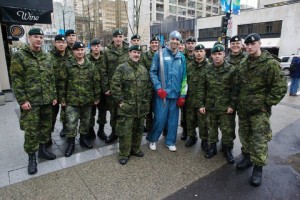Sledge hockey: a game for all
MRU student and war-veteran Mark Fushko discusses the sledge experience
Bobby Danger Jones
Sports Editor
If you’re passing through the halls of Mount Royal University and tried to pick out Cpl. Mark Fushko, unless he’s wearing shorts, you’d have a hard time noticing he’s a bilateral amputee below the knee. Fushko has bravely served the Canadian forces for 12 years and lost his legs after the vehicle he was driving triggered an improvised explosive device (IED) while on tour in the Kandahar province of Afghanistan. The Reflector spoke to him about life, the Olympics and how Sledge hockey has positively impacted his life.
The Reflector: With the Paralympics just days away, will you be following our nation’s teams closely?
Mark Fushko: I think I will try to follow certain sports that I have specific interest in. I was lucky with the military’s Soldier On program to actually go to the Paralympics when they were in Vancouver. So, that was awesome to see the level of competition that’s out there, because I think people forget that they are serious athletes. Adaptive sports are just as challenging, and in some cases more, then it can be for non-disabled people, and I will follow it to the extent that I can.

Sledge hockey takes place every Monday and Wednesday from 7:30-8:45 p.m. at the Markin MacPhail Centre. Photo courtesy: Facebook
TR: Do you feel the Paralympics get the coverage and promotion they deserve?
MF: I think some sports do, for example Sledge Hockey is probably the one with the most awareness and most coverage. For example, in 2010 if Canada had made the gold medal match, they were expecting a Grey Cup sized crowd, so that shows you that there is exposure, but if it just stems from hockey, who knows.
TR: Can you sum up sledge hockey in a few sentences, and what it means to you?
MF: Sledge hockey is essentially having a sled and skate strapped to your ass and you use two sticks that have sharp spikes to propel yourself around the ice and you get to smash and bang with other disabled people. It’s great.
TR: How did you get involved?
MF: I got involved with sledge hockey through the military’s Soldier On program. When injured and coming from the military, you’re active, similar to being a pro athlete. Soldier On’s premise is rehab through sport, so they did a camp and strapped me to a sled, and from the first time I tried it I thought, “This is awesome.”
TR: How do the rules vary from standard ice hockey?
MF: All the rules are essentially the same barring two minor differences. You can be assessed a penalty for “picking”. That’s using the claws on the end of the sticks to stab another player (laughs). Then there’s another infraction called T-Boning, you can’t T-Bone another player with your sled even though it is an effective form.
TR: Is there the regular beer-drinking camaraderie that’s associated with recreational ice hockey, or is it more serious?
MF: Everybody is super laid back, but everyone is also super competitive. The challenge is [that] a lot of people who come out for sledge weren’t previously athletes, they are just doing something to feel empowered. So the people that play sledge run the gambit from recreational to serious, hard-core national level athletes.
TR: What kind of people comprise your roster?
MF: There is definitely a diverse group of backgrounds, for example there is a firefighter on my team, there are a couple run-of-the-mill regular people, there’s a handful of military guys, including a guy from Quebec who is on the national team right now. The military has a large presence because of all the injuries coming back from Afghanistan, but it’s all walks of life, people hurt in car accidents, people with bad legs and congenital disabilities as well.
TR: Are you finding that winter sports are becoming more accommodating and accessible to the public?
MF: I would say with more exposure comes interest and opportunities to participate and people really want to get out and give it a try. Wheelchair basketball is very popular and sledge is getting big.
TR: How could an able-bodied or disabled person get started?
MF: There are all sorts of groups that allow you to get involved, you can actually be able-bodies and play on a team, so I’m actually trying to get as many people to come out and try as possible. It’s hard to get the right numbers of people to come out and stick with it. If anyone wants to get involved they can find me. You can find me around The Hub or the campus. It’s kind of harder to spot me when I’m not wearing shorts.




